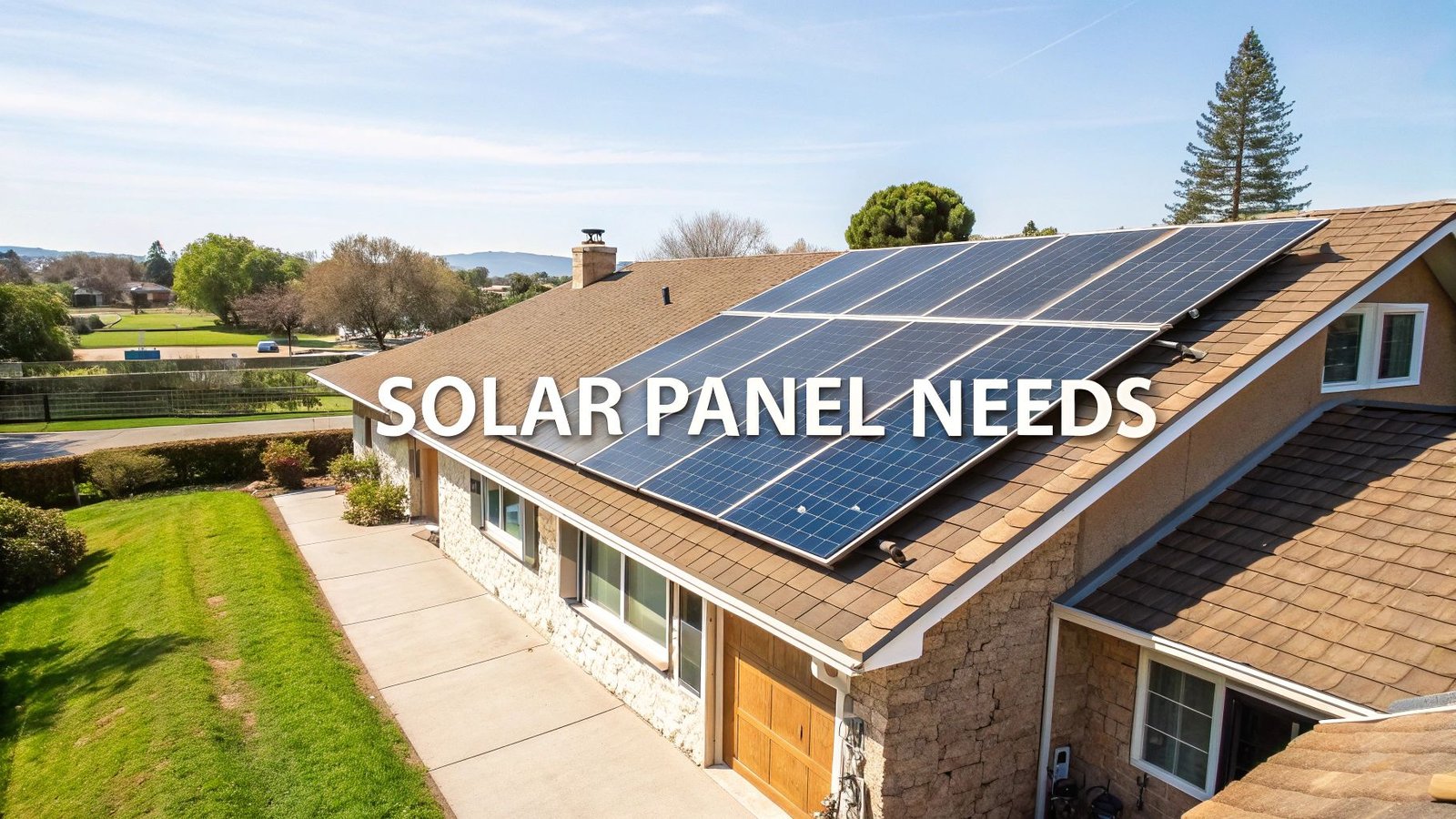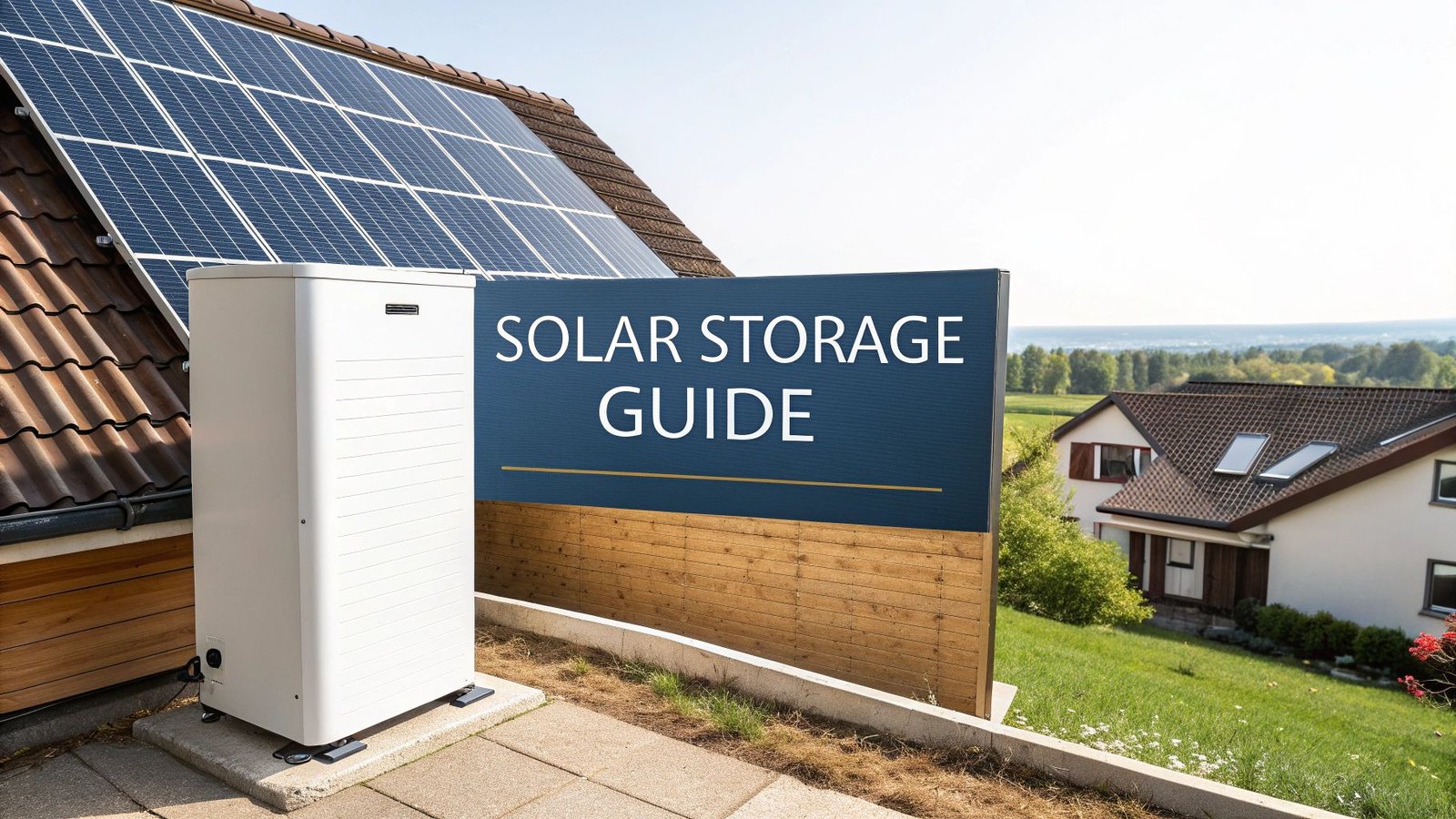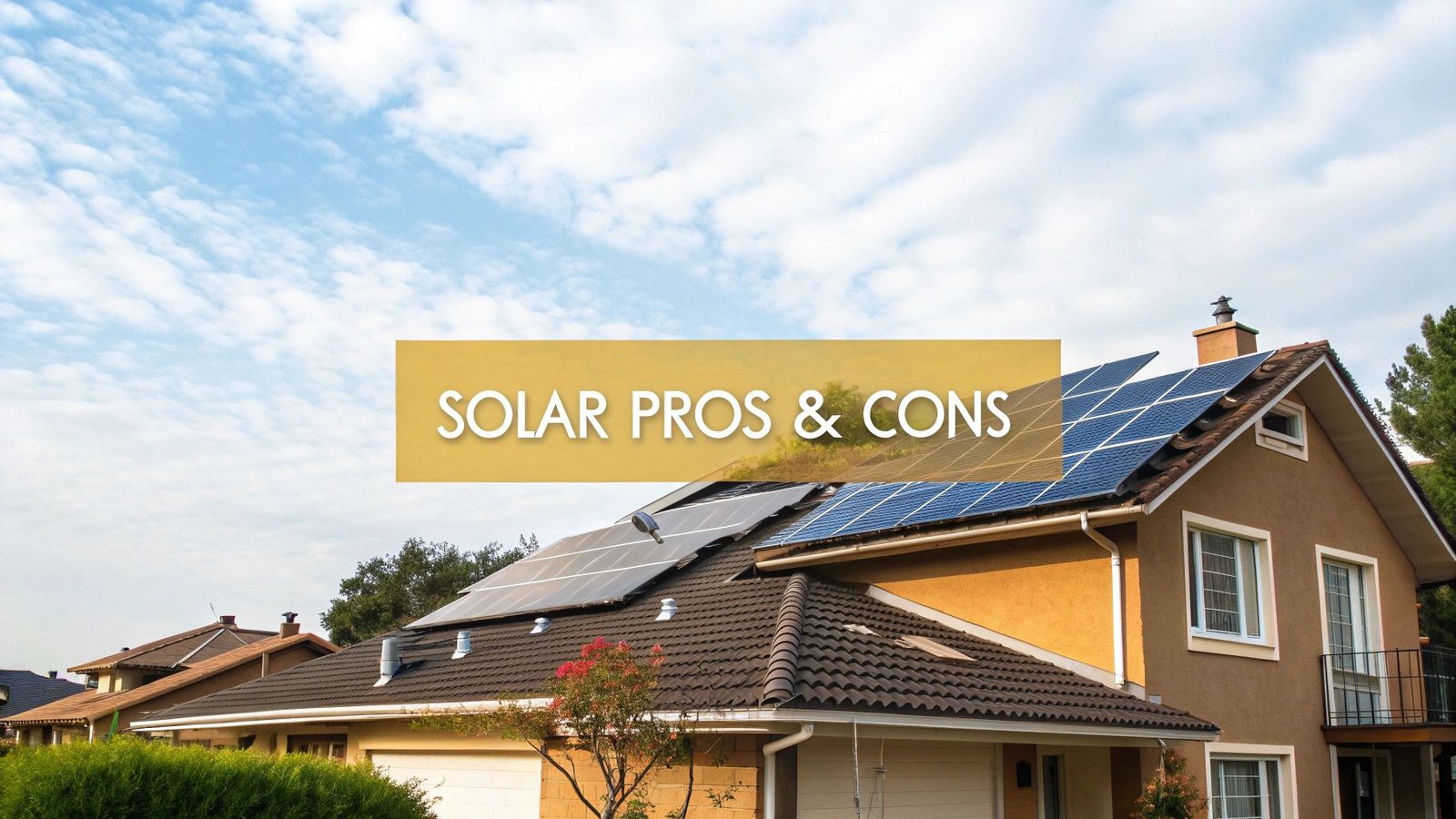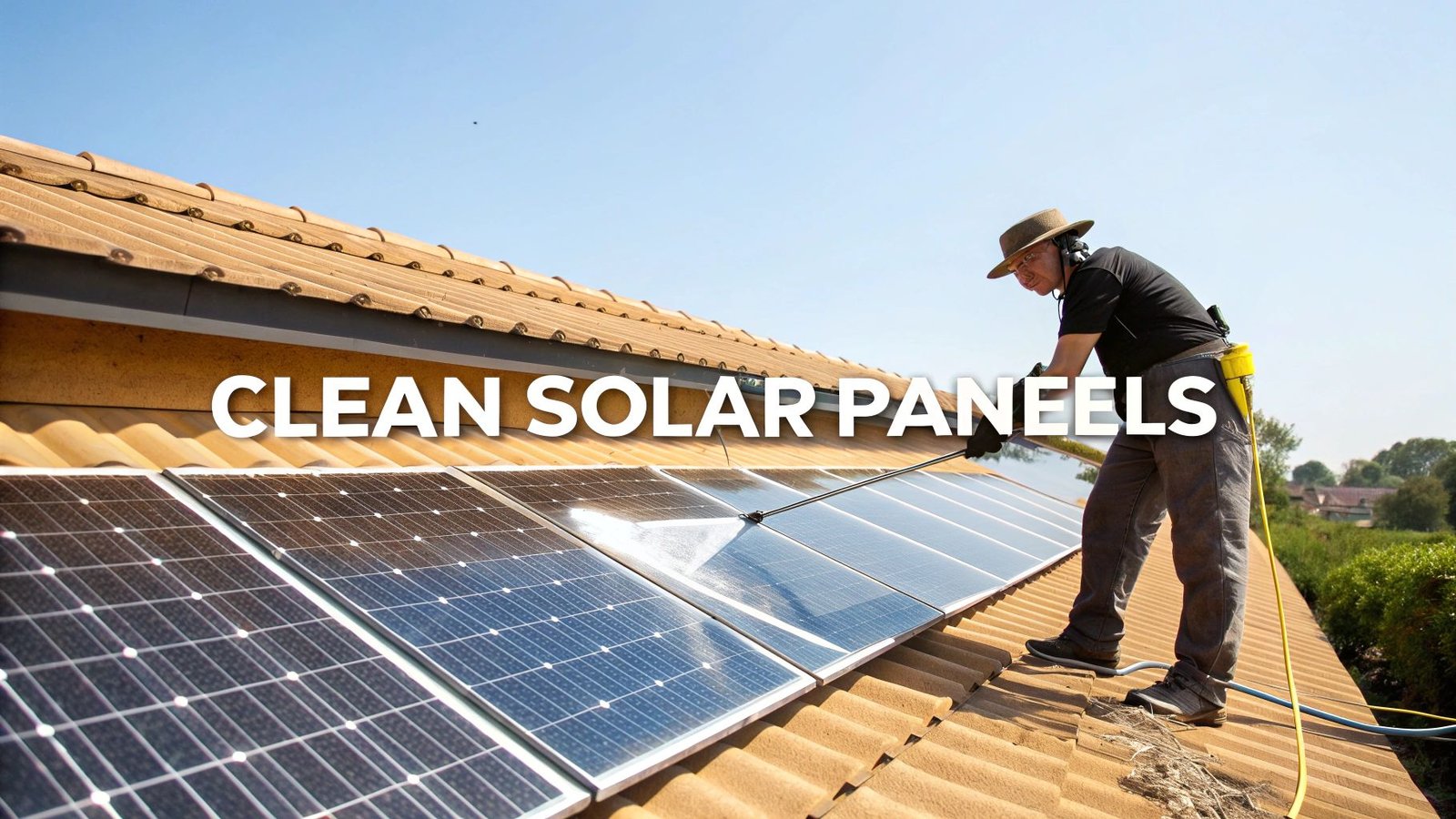Before you can even think about solar panels, you have to get a handle on your home's energy appetite. This is the absolute first step, and it's all about figuring out your average daily and monthly kilowatt-hour (kWh) usage. This number is the bedrock of your entire solar project.
Start With Your Home’s Energy Use
Forget panel wattages and sun hours for a moment. The real starting point is building an accurate energy profile for your household. This isn't a guessing game; it's about digging into the data on your past utility bills.
Your electricity bill is packed with information, but the golden ticket is the line item that says "kWh Used" or something similar. But don't just grab one bill and call it a day. A single month is just a snapshot in time and can be wildly misleading.
Analyze a Full Year of Energy Data
To get the real story, you need to round up 12 consecutive months of utility bills. This is non-negotiable. Why? Because your energy use swings dramatically throughout the year. Your air conditioner might be running full-tilt in July, sending your usage through the roof, while you barely use any electricity in the milder spring and fall months.
Looking at a full year of data lets you calculate a true annual average that smooths out those seasonal peaks and valleys. This is how you avoid designing a system that’s too small to handle the summer heat or way too big for the rest of the year.
Key Takeaway: Your annual kWh consumption is the most important number in solar planning. It sets the exact target your future solar panel system needs to hit to cover your energy needs.
Create Your Household Energy Profile
With 12 bills in hand, it's time to chart out your consumption. This simple exercise helps you see not just how much power you use, but when you use it. Below is a quick look at how a household's usage can change month-to-month. This is why we zero in on that annual average to get our calculations right.
Sample Monthly Electricity Usage (kWh)
This chart illustrates how a household’s energy use can fluctuate, with a summer peak in July. The annual average smooths these variations. Annual Total: 11,500 kWh | Daily Average: 31.5 kWh.
As you're tallying up your usage, don't forget the big energy hogs. For example, understanding different pool heating options and their energy consumption can uncover a huge chunk of your electricity use that your solar array will need to cover.
Ultimately, sizing your solar system comes down to your personal energy habits. While the average U.S. household uses around 877 kWh per month, the only number that truly matters is your own.
Find Your Local Peak Sun Hours

Alright, you've figured out how much energy your home uses. Now for the other side of the equation: sunlight.
But it’s not as simple as counting daylight hours. The number that really matters in the solar world is peak sun hours. This is a standard way to measure the intensity of sunlight in a specific location, not just its duration.
Think about it—the sun is way more powerful at high noon than it is at 8 a.m. or 5 p.m. A "peak sun hour" is the equivalent of one hour when the sun's intensity is at its peak, which is defined as 1,000 watts of solar energy hitting one square meter of surface. This is the metric that tells you the true solar potential of your roof.
It’s also why a house in sunny Phoenix will pump out way more power than an identical solar setup on a home in Portland. The Arizona sun is just stronger, for more of the day.
How to Find Your Area's Peak Sun Hours
You don’t have to guess or become an amateur meteorologist to get this number. Thankfully, the U.S. National Renewable Energy Laboratory (NREL) has already done the hard work for us.
Their free online tool, the PVWatts Calculator, is the industry standard. Just punch in your address, and it will give you a detailed breakdown of the average solar radiation for your exact spot, which directly translates into your peak sun hours.
Let's look at a real-world example of how much this can vary:
Average Daily Peak Sun Hours by City
A comparison showing the significant difference in solar potential between a sunny and a less sunny location.
This massive difference is a game-changer. The homeowner in Seattle is going to need a significantly larger system to generate the same amount of electricity as the one in Phoenix.
Key Takeaway: Never, ever use a generic national average for this calculation. Getting a location-specific number from a tool like PVWatts is absolutely critical for designing a system that actually meets your needs without being oversized or, worse, underpowered.
Making the Most of the Sunlight You Get
Your local peak sun hour value is your starting point, but the physical placement of your panels determines how much of that potential you actually capture. Two factors are incredibly important here: the direction your roof faces and its angle.
Roof Orientation and Tilt
-
Orientation: For anyone in the Northern Hemisphere, a roof that faces due south is the holy grail. It’s going to get the most direct sun all day long. If your roof faces east or west, don’t worry—you can still go solar. Just know that your production might be 15-20% lower than a perfect south-facing array.
-
Tilt Angle: The ideal tilt for your panels generally matches your home's latitude. This helps optimize energy capture throughout the seasons. A good installer will find the sweet spot that gives you the best year-round performance.
This chart gives you a clear picture of how much orientation matters. A perfect south-facing system is your 100% benchmark.

Getting a handle on your specific peak sun hours and thinking through your panel placement is fundamental. It ensures you're squeezing every last drop of energy out of the sun, which is the whole point of an efficient, cost-effective solar installation.
Time To Pick Your Panels and Get Real About Their Output

With your home's energy appetite and local sunlight hours figured out, we can finally get to the fun part: the hardware. It’s a common misconception that all solar panels are more or less the same. In reality, the specific type you pick will have a massive impact on your final system size and cost.
For homeowners, the choice usually boils down to two main technologies: monocrystalline and polycrystalline panels.
You've probably seen monocrystalline panels—they're the sleek, all-black ones. Made from a single, pure silicon crystal, they pack a bigger punch in a smaller space thanks to their higher efficiency. If you have a small roof, these are almost always the way to go.
Polycrystalline panels are the ones with that classic blue, marbled look. They’re made by melting multiple silicon fragments together, which makes them cheaper to produce. The trade-off is that they are less efficient, so you'll need a larger array to generate the same amount of electricity. Picking the right one is a huge piece of the puzzle, which we cover in-depth in our guide on how to choose solar panels.
Wattage vs. Efficiency: What Really Matters?
When you start shopping, you’ll see panels rated by their power output in watts (W). Modern residential panels typically fall in the 370W to over 400W range. While a higher wattage is great, it doesn't tell the whole story. The efficiency rating is the number you really want to pay attention to.
Efficiency is simply how good a panel is at converting sunlight into electricity. A more efficient panel will generate more power from the exact same footprint on your roof.
- A 21% efficient panel might be rated at 400W.
- A 17% efficient panel of the same physical size could be rated at just 320W.
That difference adds up fast. Choosing the 400W panels might mean you only need 20 of them, while you'd need 25 of the 320W panels to hit the same energy goal. That’s a lot of extra space and hardware.
Don't Get Fooled by Lab Numbers
Here’s something most people don't realize: a panel's wattage rating is based on its performance in a sterile lab under perfect conditions. Your roof is not a lab. Several real-world factors will chip away at that ideal output.
A Pro Tip: One of the biggest mistakes I see homeowners make is assuming they'll get the wattage printed on the label. Always build in a buffer for real-world performance drops, or you’ll end up with an undersized system that doesn't meet your needs.
Two of the biggest culprits are heat and age. Solar panels are tested at a cool 77°F (25°C), but on a hot summer day, your dark roof can easily climb well past that, causing efficiency to drop. On top of that, every panel degrades over time, slowly losing its ability to produce power. A good quality panel will still guarantee 85-90% of its day-one output after 25 years, but that slow decline is inevitable.
Fortunately, technology is always improving. The average efficiency of standard panels is now around 20-22%, a huge leap from just a decade ago. Factoring these real-world numbers into your math is the only way to ensure your solar array performs as expected for years to come.
Bringing It All Together to Calculate Your System Size
Alright, this is where the rubber meets the road. You’ve done the homework: you know your energy consumption, you’ve figured out your local peak sun hours, and you have an idea of the panels you want to use. Now, we'll pull all those numbers together to calculate the exact size of the solar system you need (in kilowatts, or kW) and, from there, how many panels that translates to.
Don't worry, this part isn't as intimidating as it might seem. The core idea is simple: we're figuring out how much solar capacity you need to hit your daily energy target. Let's walk through a real-world example to make it crystal clear.
This diagram gives you a great visual breakdown of the basic formula, showing how we get from your home's energy use to a final panel count.

As you can see, the logic flows from your daily energy goal, which, when divided by a single panel's daily output, gives you the number of panels your home needs.
Factoring in Real-World Energy Loss
Before we get to the math, there's a crucial piece of the puzzle we can't ignore: the system inefficiency factor. The truth is, no solar panel system is 100% efficient. You're always going to lose a little bit of energy as it travels from the panels on your roof into your home.
This loss, sometimes called a "derate factor," comes from a few different places. It's a completely normal part of any electrical system, and building it into our calculation is the key to designing an array that actually performs as expected.
Here's a look at the typical culprits that chip away at your system's efficiency.
Sources of Solar System Energy Loss
- High Temperatures (5-15%)
- Soiling (Dirt, Dust) (2-5%+)
- Inverter Conversion (2-5%)
- Wiring & Connections (1-2%)
- Panel Mismatch (1-2%)
This chart shows the common factors that reduce a solar system’s output. An inefficiency factor accounts for these combined losses.
As you can see, these small percentages can add up. That's why we have to account for them from the start.
To build a realistic buffer, industry professionals typically multiply the initial system size calculation by a factor of 1.20. This effectively bumps up the system size by 20%, ensuring your array generates enough power to cover your needs even with these inevitable losses.
A Practical Calculation Example
Let's put this into practice with a common household scenario.
Imagine a family that uses an average of 30 kWh of electricity each day. They live in an area that gets about 4.5 peak sun hours, and they've decided to go with efficient 400-watt solar panels for their roof.
Here’s how we'd break down the math:
-
First, find the required system size in kW:
- (Daily Energy Use ÷ Peak Sun Hours) × Inefficiency Factor
- (30 kWh ÷ 4.5 hours) × 1.20 = 8.0 kW
- So, this home needs an 8.0-kilowatt system to reliably meet its daily energy demands after we account for real-world inefficiencies.
-
Next, determine the number of panels:
- (System Size in Watts ÷ Panel Wattage)
- First, convert kW to Watts: 8.0 kW = 8,000 Watts
- (8,000 Watts ÷ 400 Watts/panel) = 20 panels
The final count is in: this family needs 20 of their chosen 400W panels to hit their energy goals.
This number is incredibly valuable. It gives you a solid starting point for understanding your project's scope and the potential solar panel system installation cost. When you have this data in hand, you can walk into a conversation with any solar installer feeling much more confident and informed.
Fine-Tuning Your Plan with Local Factors

A perfect on-paper calculation is a fantastic starting point. But let's be honest—the real world is where your solar investment either shines or falls flat. Your final decision on system size shouldn't just be about kWh and panel wattage; it needs to be firmly rooted in the economic realities of your specific location.
Think of it this way: local incentives, utility policies, and even the competitiveness of the solar market in your area can completely change the math on your project. These factors are every bit as important as your energy usage when figuring out the right system size for the best return.
The Impact of Local Incentives and Policies
The financial sense of your solar array often comes down to local programs. A generous state tax credit, for instance, could make a larger system much more affordable, letting you shoot for a 100% energy offset instead of settling for 80%.
On the flip side, weak net metering policies can make oversizing your system a costly mistake. If your utility only credits you pennies on the dollar for the excess power you feed back into the grid, there's no financial reason to produce more than you use.
Here are the key local factors you need to dig into:
- State and Local Rebates: Many states, cities, and even specific utility companies offer cash-back rebates that can take a serious chunk out of your upfront costs.
- Net Metering Rules: This is a big one. You need to know exactly how your utility credits you for surplus solar power. The policies vary wildly from one provider to the next.
- Performance-Based Incentives (PBIs): Some areas have programs like Solar Renewable Energy Certificates (SRECs), which actually pay you for the clean energy your system generates.
Regional Market Conditions Matter
The solar industry isn't the same everywhere. The cost to install a system and even the availability of certain panels can change dramatically depending on where you live, which directly impacts your budget and final panel count.
The numbers don't lie. In the first quarter of 2025, the U.S. installed a massive 10.8 GWdc of solar capacity, but that growth wasn't spread out evenly. States like Texas, Florida, and California were responsible for a whopping 65% of those utility-scale installations, leading to highly competitive local markets. You can see the full breakdown in the latest solar market insight report from SEIA.
Real-World Impact: What does this mean for you? In a mature solar market with plenty of installers, you’re in a great position to get competitive quotes. But in an area where solar is just taking off, costs might be higher and your equipment choices more limited. This could be the deciding factor between splurging on high-efficiency panels or sticking with a standard model.
Getting a handle on these local dynamics is what separates a good investment from a great one. When you combine your technical calculations with a clear-eyed view of the local economic landscape, you can truly design the perfect solar project. For a deeper look at making your home energy-independent, explore our guide on using solar energy for my home.
Common Questions About Sizing Your Solar System
Even after you've run the numbers, a few questions usually pop up. It's totally normal. Sizing a solar system often gets you thinking about all the "what ifs," so let's walk through some of the most common ones I hear from homeowners.
Thinking ahead now can save you a lot of headaches and money down the road, ensuring your system is built for the long haul.
What If My Energy Needs Change in the Future?
This is probably the most important question you can ask. If you have big plans on the horizon, you absolutely need to account for them before you sign on the dotted line.
Are you eyeing an electric vehicle? Dreaming of a new hot tub? Maybe you're planning to swap out your old furnace for an electric heat pump. All of these are major energy hogs that will drive up your kWh usage, and it’s always cheaper to install a few extra panels from the start than to add them on later.
My Two Cents: Take a moment and estimate the future annual kWh for any of those big-ticket items. Add that number to your current yearly total. This simple step is the key to future-proofing your solar investment.
How Does Adding a Battery Affect My Panel Calculation?
Adding a solar battery gives you incredible energy security, but it doesn't really change how many panels you need on the roof. The core math stays the same.
Your solar panels are still sized to cover your total energy consumption. The battery's job is simply to store the extra juice your panels produce when the sun is high. You can then pull from that stored energy at night, during a grid outage, or when your utility company is charging peak rates. Your installer will help you pick the right size battery, but the number of panels needed to charge it is based on your original energy goals.
Do I Need to Cover 100 Percent of My Electricity Bill?
Honestly, no. While getting a 100% energy offset and wiping out your power bill sounds great, it isn't always the smartest financial decision. It really boils down to your personal goals and, more importantly, your local utility's rules for net metering.
Some utilities don't pay you the full retail rate for the extra power you send back to their grid. If that's the case where you live, sizing your system to cover 90% or 95% of your usage might give you a much better return on your investment. The calculation is the same—you just adjust your target kWh to match that new percentage.
Ready to take the next step toward energy independence? The experts at Radiant Energy can provide a free, no-obligation consultation to help you design the perfect solar solution for your home. Visit us at https://radiantenergysolar.com to get started.




